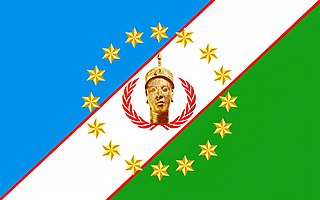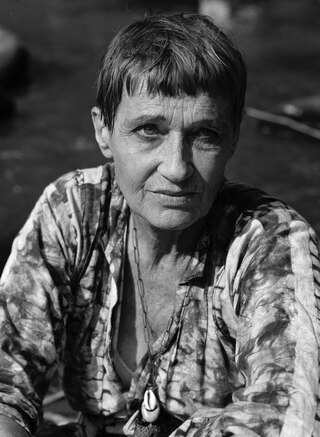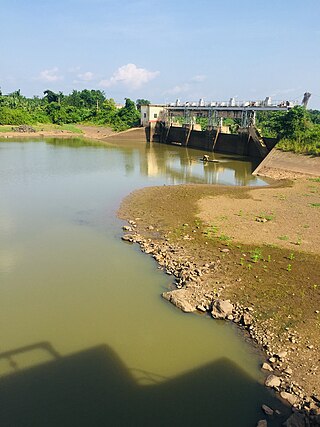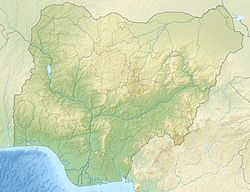
Oshun is an orisha, a spirit, a deity, or a goddess that reflects one of the manifestations of the Yorùbá Supreme Being in the Ifá oral tradition and Yoruba-based religions of West Africa. She is one of the most popular and venerated Orishas. Oshun is an important river deity among the Yorùbá people. She is the goddess of divinity, femininity, fertility, beauty, and love. She is connected to destiny and divination.

Ifẹ̀ is an ancient Yoruba city in south-western Nigeria, recent in-depth archeologically estimates suggest Ife's founding to be between the 10th century BC and 6th century BC and is widely agreed upon by historians to be the oldest amongst the classical and post-classical Yoruba city-states. The city is located in present-day Osun State. Ifẹ̀ is about 218 kilometers northeast of Lagos with a population of over 500,000 people, which is the highest in Osun State according to population census of 2006.

Osogbo is a city in Nigeria. It became the capital city of Osun State in 1991. Osogbo city seats the Headquarters of both Osogbo Local Government Area and Olorunda Local Government Area. It is some 88 kilometers by road northeast of Ibadan. It is also 108 kilometres (67 mi) by road south of Ilorin and 108 kilometres (67 mi) northwest of Akure. Osogbo shares boundaries with Ikirun, Ilesa, Ede, Egbedore, Ogbomosho and Iragbiji and it is easily accessible from any part of the state because of its central nature. It is about 48 km from Ife, 32 km from Ilesa, 46 km from Iwo, 48 km from Ikire and 46 km from Ila-Orangun; the city had a population of about 200,000 people and an approximate land area of 126 km. The postal code of the area is 230.

Osun State, occasionally known as the State of Osun by the state government, is a state in southwestern Nigeria; bounded to the east by Ekiti and Ondo states for 84 km and for 78 km respectively, to the north by Kwara State for 73 km, to the south by Ogun State for 84 km and to the west by Oyo State, mostly across the River Osun. Named for the River Osun—a vital river which flows through the state—the state was formed from the southeast of Oyo State on 27 August 1991 and has its capital as the city of Osogbo.

The Oṣun River, Yoruba: Odò Ọ̀ṣun, is a river of Yorubaland that rises in Ekiti State and flows westwards into Osun State before turning southwestwards at its confluence with the Erinle River near the town of Ede and then heading south at the Asejire reservoir flowing though the rest of the state and Ogun State in Southwestern Nigeria before eventually discharging into the Lekki Lagoon and the Atlantic at the Gulf of Guinea.

Chief Nike Davies-Okundaye, also known as Nike Okundaye, Nike Twins Seven Seven and Nike Olaniyi, is a Nigerian Yoruba and adire textile designer. She is best known as an artist for her cloth work and embroidery pieces.
Chief Horst Ulrich Beier, commonly known as Ulli Beier, was a German editor, writer and scholar who had a pioneering role in developing literature, drama and poetry in Nigeria, as well as literature, drama and poetry in Papua New Guinea.

Twins Seven Seven, born Omoba Taiwo Olaniyi Oyewale-Toyeje Oyelale Osuntoki was a Nigerian painter, sculptor and musician. He was an itinerant singer and dancer before he began his career as an artist, first attending in 1964 an Mbari Mbayo workshop conducted by Ulli Beier and Georgina Beier in Osogbo. Twins Seven Seven went on to become one of the best known artists of the Osogbo School.

The Yoruba people are a West African ethnic group who mainly inhabit parts of Nigeria, Benin, and Togo. The areas of these countries primarily inhabited by the Yoruba are often collectively referred to as Yorubaland. The Yoruba constitute more than 48 million people in Africa, are over a million outside the continent, and bear further representation among members of the African diaspora. The vast majority of the Yoruba population is today within the country of Nigeria, where they make up 20.7% of the country's population according to Ethnologue estimations, making them one of the largest ethnic groups in Africa. Most Yoruba people speak the Yoruba language, which is the Niger-Congo language with the largest number of native or L1 speakers.
Akin Fakeye, is a Nigerian artist who works in the medium of wood carving.
Esa-Oke is a Yoruba town located at the Obokun Local Government Area of the Ijesa North Federal Constituency of Ife/Ijesa Senatorial District of Osun State, South-West of Nigeria. It is a native Ijesa (Ijesha) community and shares boundaries with other towns namely: Oke-Imesi, Imesi-ile, Ijebu-Ijesa, Esa-Odo, Efon-Alaaye. Omiran Adebolu, a member of the Olofin family of Ile-Ife, though disputably, was believed to have founded Esa-Oke after he left Ile-Ife in 1184 A.D.
Ileogbo is the headquarters of Aiyedire Local Government in Osun State, Nigeria. It is situated midway between Ibadan and Osogbo, the capitals of Oyo and Osun State. Ibadan is about 44 km to the south of Ileogbo while Osogbo is about 42 km to its north, Oyo 40 km to its west, while Gbongan and Ife are located to the east of the town.

Susanne Wenger MFR, also known as Adunni Olorisha, was an Austrian-Nigerian artist and Yoruba priestess who expatriated to Nigeria. Her main focus was the Yoruba culture and she was successful in building an artist cooperative in Osogbo. She partnered with local artists in Osogbo to redevelop and redecorate the Osun Osogbo Sacred Grove with sculptures and carvings depicting the various activities of the Orishas.

The Olojo Festival is an ancient festival celebrated annually in Ife, Osun State, Nigeria. It is one of the popular festivals in the Yoruba land, and was once described by Oba Adeyeye Enitan Ogunwusi as a festival that celebrates the Black race all over the world. The Yoruba word 'Olojo' means 'The Day Of The First Dawn' that describes the grateful heart of man towards God's creation and the existence of Human. The Olojo Festival is a culture festival in the calendar of the Ile-Ife, Osun State which is located in the Southwestern part of Nigeria. It is the celebration of the remembrance of “Ogun”, god of Iron, who is believed to be the first son of Oduduwa, progenitor of the Yoruba people. The festival is held annually in October. It is one of the biggest festival on the culture calendar of lle-Ife.

The Erinle River is a river in the ancient town of Ido-Osun,Osun State, Nigeria, a right tributary of the Osun River, which it enters from the north near Ido-Osun,Egbedore Local Government, Osun state Nigeria just below the Erinle Dam. Another reservoir, the new Erinle Dam, lies higher up the river. Water from the two dams supplies Osogbo, the state capital. A few meters away from the River lays the M.K.O Abiola international airport, Ido-Osun and as well the defunct Electricity Cooperation of Nigeria, Erinle Power station in Ido-Osun, Osun state.
Adebisi Akanji is a Nigerian artist as well as the Olúwo of Ilédì Lárọ̀ Ohùntótó - the main Ògbóni Ìbílẹ̀ lodge of Òṣogbo, capital of Ọ̀ṣun State, Nigeria.
Ifáyẹmi Ọ̀ṣúndàgbonù Elebuibon is a Yoruba and Nigerian writer, poet, author, linguist, and a world-famous Ifa priest. His plays and films have received worldwide acclamation for his pursuit of the preservation of Yoruba culture and heritage. He also serves as a traveling lecturer in several institutions including at the department of African language and literature at the Obafemi Awolowo University and Black Studies at the San Francisco State University and at the Wajumbe Cultural Institution in California.
Chief Muraina Oyelami is a Nigerian painter and drummer of Yoruba descent. He was among the first generation of artists to come out of the Osogbo School of Art in the 1960s. He was a drummer and actor with the theatre company of Duro Ladipo. He taught traditional music and dance at Obafemi Awolowo University from 1976 to 1987. As a musician, he trained in the dùndún and the Batá drum. He was the chief of his hometown Iragbiji.




















